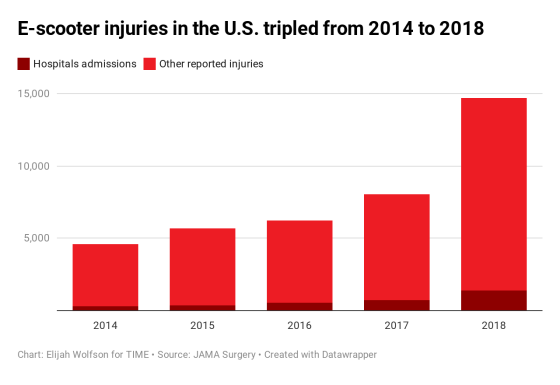If you’ve set foot in an American city in the past few years, you’ve almost certainly seen sidewalks littered with electronic scooters. Souped up versions of what were once seen as children’s toys have been pitched as the future of urban commuting: a greener, cleaner and more compact alternative to cars, and one with arguably an even lower barrier to entry than bicycles. While there’s debate as to whether scooters will fully deliver on that promise, they’re undeniably popular; the National Association of City Transportation Officials reports that in 2018, people took 38.5 million trips on shared scooters from brands like Bird, Lime and Spin.
But with that popularity comes a new “urban health scare,” according to a new research letter published in JAMA Surgery and based on data from the National Electronic Injury Surveillance System.

From 2014 to 2018, the researchers report, more than 39,000 people in the U.S. were injured from riding these seemingly sedate scooters, and about 3,300 people were admitted to the hospital. More than 14,500 of those injuries and almost 1,400 hospital admissions occurred in 2018 alone, compared to about 8,000 and 700, respectively, just the year before.
About a third of injuries recorded in 2018 affected the head, the researchers report—which actually makes the rate of head injuries relative to all injuries among scooter riders more than double that seen among cyclists, the paper says. The most common injuries from 2014 to 2018 were fractures; bruises and abrasions; and cuts.
Perhaps unsurprisingly, 18- to 34-year-olds were the most commonly injured age group, and men accounted for about two-thirds of scooter accidents.
While scooters may seem like a relatively risk-free way to zip around a city, this isn’t the first study to look at injuries among riders. A case study out of Austin, Tex., for one, found that almost 200 people there reported e-scooter-related injuries over the course of just three months in 2018.
“The nearly doubling of incident e-scooter trauma calls for improved rider safety measures and regulation,” the authors of the new paper write, adding that many minor scooter-related injuries may go unreported.
A good place to start? Stepping up the number of riders who wear a helmet. According to prior studies, only 2% to 4% of injured scooter riders were wearing a helmet when they got hurt.
